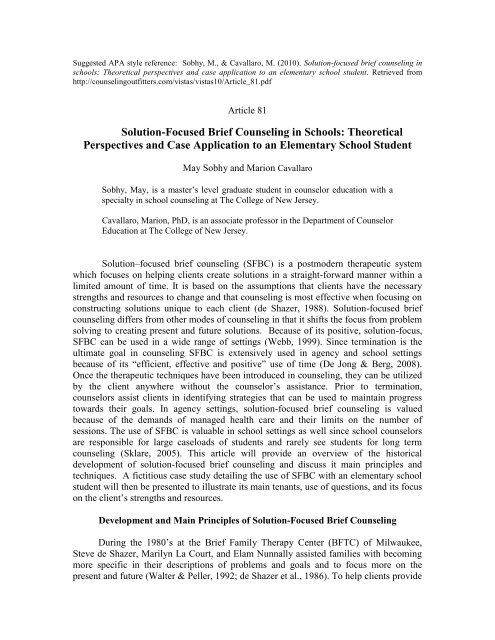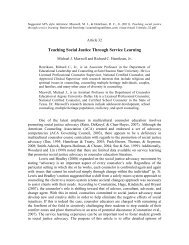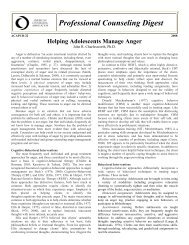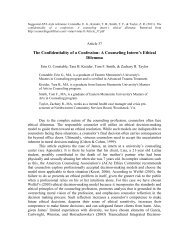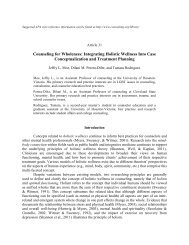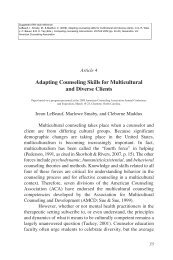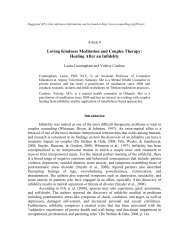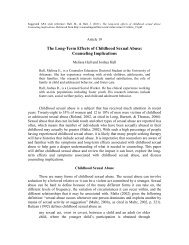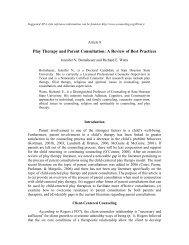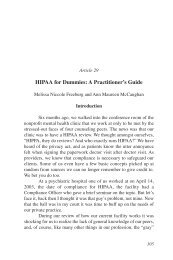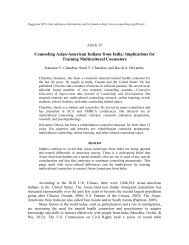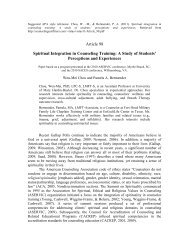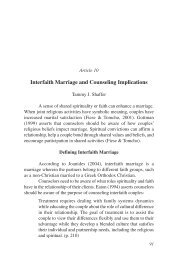Solution-Focused Brief Counseling in Schools - Counselingoutfitters ...
Solution-Focused Brief Counseling in Schools - Counselingoutfitters ...
Solution-Focused Brief Counseling in Schools - Counselingoutfitters ...
Create successful ePaper yourself
Turn your PDF publications into a flip-book with our unique Google optimized e-Paper software.
Suggested APA style reference: Sobhy, M., & Cavallaro, M. (2010). <strong>Solution</strong>-focused brief counsel<strong>in</strong>g <strong>in</strong><br />
schools: Theoretical perspectives and case application to an elementary school student. Retrieved from<br />
http://counsel<strong>in</strong>goutfitters.com/vistas/vistas10/Article_81.pdf<br />
Article 81<br />
<strong>Solution</strong>-<strong>Focused</strong> <strong>Brief</strong> <strong>Counsel<strong>in</strong>g</strong> <strong>in</strong> <strong>Schools</strong>: Theoretical<br />
Perspectives and Case Application to an Elementary School Student<br />
May Sobhy and Marion Cavallaro<br />
Sobhy, May, is a master’s level graduate student <strong>in</strong> counselor education with a<br />
specialty <strong>in</strong> school counsel<strong>in</strong>g at The College of New Jersey.<br />
Cavallaro, Marion, PhD, is an associate professor <strong>in</strong> the Department of Counselor<br />
Education at The College of New Jersey.<br />
<strong>Solution</strong>–focused brief counsel<strong>in</strong>g (SFBC) is a postmodern therapeutic system<br />
which focuses on help<strong>in</strong>g clients create solutions <strong>in</strong> a straight-forward manner with<strong>in</strong> a<br />
limited amount of time. It is based on the assumptions that clients have the necessary<br />
strengths and resources to change and that counsel<strong>in</strong>g is most effective when focus<strong>in</strong>g on<br />
construct<strong>in</strong>g solutions unique to each client (de Shazer, 1988). <strong>Solution</strong>-focused brief<br />
counsel<strong>in</strong>g differs from other modes of counsel<strong>in</strong>g <strong>in</strong> that it shifts the focus from problem<br />
solv<strong>in</strong>g to creat<strong>in</strong>g present and future solutions. Because of its positive, solution-focus,<br />
SFBC can be used <strong>in</strong> a wide range of sett<strong>in</strong>gs (Webb, 1999). S<strong>in</strong>ce term<strong>in</strong>ation is the<br />
ultimate goal <strong>in</strong> counsel<strong>in</strong>g SFBC is extensively used <strong>in</strong> agency and school sett<strong>in</strong>gs<br />
because of its “efficient, effective and positive” use of time (De Jong & Berg, 2008).<br />
Once the therapeutic techniques have been <strong>in</strong>troduced <strong>in</strong> counsel<strong>in</strong>g, they can be utilized<br />
by the client anywhere without the counselor’s assistance. Prior to term<strong>in</strong>ation,<br />
counselors assist clients <strong>in</strong> identify<strong>in</strong>g strategies that can be used to ma<strong>in</strong>ta<strong>in</strong> progress<br />
towards their goals. In agency sett<strong>in</strong>gs, solution-focused brief counsel<strong>in</strong>g is valued<br />
because of the demands of managed health care and their limits on the number of<br />
sessions. The use of SFBC is valuable <strong>in</strong> school sett<strong>in</strong>gs as well s<strong>in</strong>ce school counselors<br />
are responsible for large caseloads of students and rarely see students for long term<br />
counsel<strong>in</strong>g (Sklare, 2005). This article will provide an overview of the historical<br />
development of solution-focused brief counsel<strong>in</strong>g and discuss it ma<strong>in</strong> pr<strong>in</strong>ciples and<br />
techniques. A fictitious case study detail<strong>in</strong>g the use of SFBC with an elementary school<br />
student will then be presented to illustrate its ma<strong>in</strong> tenants, use of questions, and its focus<br />
on the client’s strengths and resources.<br />
Development and Ma<strong>in</strong> Pr<strong>in</strong>ciples of <strong>Solution</strong>-<strong>Focused</strong> <strong>Brief</strong> <strong>Counsel<strong>in</strong>g</strong><br />
Dur<strong>in</strong>g the 1980’s at the <strong>Brief</strong> Family Therapy Center (BFTC) of Milwaukee,<br />
Steve de Shazer, Marilyn La Court, and Elam Nunnally assisted families with becom<strong>in</strong>g<br />
more specific <strong>in</strong> their descriptions of problems and goals and to focus more on the<br />
present and future (Walter & Peller, 1992; de Shazer et al., 1986). To help clients provide
Ideas and Research You Can Use: VISTAS 2010<br />
more specific descriptions of their goals, the counsel<strong>in</strong>g team provided clients this<br />
therapeutic task:<br />
Between now and next time we meet, we (I) would like you to observe, so<br />
that you can describe to us (me) next time, what happens <strong>in</strong> your (pick<br />
one: family, life, marriage, relationship) that you want to cont<strong>in</strong>ue to have<br />
happen. (Walter & Peller, 1992, p. 7)<br />
The above task provided a context for clients, who had previously provided only<br />
vague problems and goals, to observe the specific problems and goals, with which they<br />
now could work. They also would shift their past-oriented focus to the present and future.<br />
As a result of de Shazer, La Court, and Nunnally assign<strong>in</strong>g this task to clients, clients<br />
were not only able to search for and articulate specific problems and goals, but they were<br />
also able to describe positive changes that had occurred as a result of their search,<br />
<strong>in</strong>clud<strong>in</strong>g change they had not previously considered. These changes frequently resulted<br />
<strong>in</strong> the clients’ solutions.<br />
At the <strong>Brief</strong> Family Therapy Center, de Shazer, Insoo Kim Berg and their<br />
therapeutic team developed seven ma<strong>in</strong> pr<strong>in</strong>ciples of solution focused brief counsel<strong>in</strong>g<br />
(De Shazer et al., 1986). The pr<strong>in</strong>ciples focus on how clients deal with problems, how<br />
they are ma<strong>in</strong>ta<strong>in</strong>ed, and how to solve them. The counselors were <strong>in</strong>terested <strong>in</strong> solutions<br />
and how they work. The first pr<strong>in</strong>ciple is that most compla<strong>in</strong>ts develop <strong>in</strong> relationships.<br />
<strong>Solution</strong>s are developed by chang<strong>in</strong>g <strong>in</strong>teractions and consider<strong>in</strong>g the limitations of the<br />
situations. The second pr<strong>in</strong>ciple is that the goal of SFBC is to help clients do someth<strong>in</strong>g<br />
different by chang<strong>in</strong>g their <strong>in</strong>teractive behavior or their <strong>in</strong>terpretation of others’ behavior<br />
so that a solution can be achieved. The third pr<strong>in</strong>ciple dictates the importance of<br />
establish<strong>in</strong>g a cooperative relationship with the client. The fourth pr<strong>in</strong>ciple states that a<br />
“new and beneficial” mean<strong>in</strong>g can be constructed from a client’s compla<strong>in</strong>t (de Shazer et<br />
al., 1986). This pr<strong>in</strong>ciple reflects the positive orientation that solution focused counsel<strong>in</strong>g<br />
holds.<br />
The fifth pr<strong>in</strong>ciple states that only a small change is necessary, which is why only<br />
a “small and reasonable” goal is essential. The counselors expla<strong>in</strong> this by stat<strong>in</strong>g<br />
One major difference between brief counsel<strong>in</strong>g and other models lies <strong>in</strong><br />
the brief counselor’s idea that no matter how awful and how complex the<br />
situation, a small change <strong>in</strong> one person’s behavior can lead to profound<br />
and far-reach<strong>in</strong>g differences <strong>in</strong> the behavior of all persons <strong>in</strong>volved. (de<br />
Shazer et al., 1986, p. 209)<br />
The counselors believe that any small changes that clients display are signs of their<br />
progress towards solutions.<br />
The sixth pr<strong>in</strong>ciple dictates that once a change occurs <strong>in</strong> one part of a person’s life,<br />
then other changes will ensue <strong>in</strong> their whole systematic lives. De Shazer, Kim Berg, and<br />
their family systems therapeutic team at the <strong>Brief</strong> Family Therapy Center expla<strong>in</strong>ed that<br />
“family therapy” means that the counselor must work to witness changes occur<br />
throughout the whole family rather than work<strong>in</strong>g with the <strong>in</strong>dividual client who is part of<br />
their family system. They also posit that an <strong>in</strong>dividual’s change needs to fit with<strong>in</strong> the<br />
limits and constra<strong>in</strong>ts of the familial system to avoid creat<strong>in</strong>g further conflict.<br />
The f<strong>in</strong>al pr<strong>in</strong>ciple states that effective counsel<strong>in</strong>g can be achieved even when the<br />
counselor cannot articulate the client’s compla<strong>in</strong>ts. More importantly, the counselor and<br />
2
Ideas and Research You Can Use: VISTAS 2010<br />
client need to collaborate on signs of when the problem has been solved. For <strong>in</strong>stance,<br />
when a client <strong>in</strong>volved <strong>in</strong> a usual troublesome <strong>in</strong>teraction behaves differently, then the<br />
counselor will know that the client is work<strong>in</strong>g towards a solution. De Shazer and the<br />
therapeutic team expla<strong>in</strong> that although listen<strong>in</strong>g to the client compla<strong>in</strong> about their<br />
problems is essential to rapport build<strong>in</strong>g, it is more important to collaboratively develop<br />
an <strong>in</strong>tervention. It is critical for the counselor to be solution focused rather than problem<br />
focused.<br />
In addition to develop<strong>in</strong>g the seven ma<strong>in</strong> pr<strong>in</strong>ciples of SFBC, deShazer, Kim Berg<br />
and their therapeutic team made recommendation about help<strong>in</strong>g clients establish concrete<br />
goals. For a goal to be well-def<strong>in</strong>ed it should meet a list of criteria, <strong>in</strong>clud<strong>in</strong>g: “<strong>in</strong> the<br />
positive, <strong>in</strong> a process form, <strong>in</strong> the present form, as specific as can be, <strong>in</strong> the client’s<br />
control, and <strong>in</strong> the client’s language” (Walter & Peller, 1992, p. 60). A goal that is<br />
positively framed should <strong>in</strong>clude the key term “<strong>in</strong>stead,” which can be used by ask<strong>in</strong>g,<br />
“What will you be do<strong>in</strong>g <strong>in</strong>stead” By ask<strong>in</strong>g problem-focused clients this question, their<br />
focus will be redirected to possible solutions. A goal that is <strong>in</strong> the process form usually<br />
<strong>in</strong>cludes the “How” and “-<strong>in</strong>g” terms, which can be used by ask<strong>in</strong>g “How will you be<br />
do<strong>in</strong>g this” Such phras<strong>in</strong>g implies that clients will be work<strong>in</strong>g towards their solutions.<br />
For the goal to be as specifically def<strong>in</strong>ed as possible counselors could ask, “How<br />
specifically will you be do<strong>in</strong>g this” Most importantly, counselors should communicate<br />
their belief <strong>in</strong> clients’ control <strong>in</strong> design<strong>in</strong>g solutions by us<strong>in</strong>g the term “you,” which they<br />
can do by ask<strong>in</strong>g, “What will you be do<strong>in</strong>g when this happens” (Walter & Peller, 1992).<br />
The use of carefully worded questions is critical <strong>in</strong> solution-focused brief counsel<strong>in</strong>g as<br />
they guide the clients’ actions.<br />
As implied by its name, solution-focused brief counsel<strong>in</strong>g has a positive<br />
orientation, which assumes that people are healthy and have the competency to construct<br />
solutions that enhance their lives. It is a nonpathological and non-deficit focused<br />
approach that assumes that people do have the ability to solve daily life challenges but at<br />
times they might lose their awareness of their competencies (Corey, 2009). Berg posits<br />
that clients are competent and that the role of the counselor is to ma<strong>in</strong>ta<strong>in</strong> an optimistic<br />
attitude by help<strong>in</strong>g clients rega<strong>in</strong> their awareness of their competencies (De Jong & Berg,<br />
2008). The counselor’s role is to build the client’s hope by creat<strong>in</strong>g positive expectations<br />
of change be<strong>in</strong>g possible. The client is often asked to reconsider their determ<strong>in</strong>istic view<br />
of their problems and consider strengths that they have previously used to cope with other<br />
problems. The client is encouraged to look for what is work<strong>in</strong>g <strong>in</strong> their lives <strong>in</strong> contrast to<br />
their previous unsuccessful problem-focused approaches. Its non-deficit focused<br />
approach emphasizes the client’s strengths through the use of its techniques, which<br />
<strong>in</strong>clude the pre-counsel<strong>in</strong>g change, exception questions, the miracle question, scal<strong>in</strong>g<br />
questions, formula first session task, and the therapeutic feedback. The client is active<br />
and directive <strong>in</strong> the participation of these techniques.<br />
Techniques<br />
As previously noted one of the ma<strong>in</strong> tenets of solution focused counsel<strong>in</strong>g states<br />
that only small change is necessary. The counselor emphasizes this pr<strong>in</strong>ciple with clients<br />
by hav<strong>in</strong>g them participate <strong>in</strong> the first task, which is to look for pre-counsel<strong>in</strong>g change<br />
(Corey, 2009). Just by schedul<strong>in</strong>g an appo<strong>in</strong>tment with the counselor, client change has<br />
3
Ideas and Research You Can Use: VISTAS 2010<br />
already occurred. The counselor would prompt clients by ask<strong>in</strong>g, “What have you done<br />
s<strong>in</strong>ce you called for the appo<strong>in</strong>tment that has made a difference <strong>in</strong> your problem” By<br />
be<strong>in</strong>g asked this question, clients are more likely to th<strong>in</strong>k about their obstacles <strong>in</strong> an<br />
optimistic, positive frame of m<strong>in</strong>d rather than a determ<strong>in</strong>istic, problem-focused context.<br />
Clients are also encouraged to depend more on their own strengths and resources to<br />
accomplish their goals rather than depend<strong>in</strong>g on their counselor.<br />
Clients learn to rely on their own strengths and resources by be<strong>in</strong>g asked<br />
exception questions, which is a task that helps clients focus on situations <strong>in</strong> their lives<br />
when they would have expected the problem to occur and it did not or did not occur as<br />
<strong>in</strong>tensely (Murphy, 2008). These times of exception serve as examples of clients’<br />
previous abilities to work towards solutions. They also rem<strong>in</strong>d clients that problems are<br />
“not all-powerful and have not existed forever” (Corey, 2009, p. 384). Most importantly,<br />
exception questions evoke clients to use resources and strengths that they have previously<br />
used to solve problems.<br />
When clients are asked to imag<strong>in</strong>e what their lives would look like without the<br />
problem, the counselor is us<strong>in</strong>g the miracle question. For example, a counselor could ask,<br />
“If a miracle happened and the problem you have was solved overnight, how would you<br />
know it was solved, and what would be different” (Sklare, 2005, p. 28). When clients<br />
are asked these questions they are encouraged to imag<strong>in</strong>e possible steps to solve their<br />
problems which helps them envision their goals. Furthermore, clients would be<br />
encouraged to envision the steps toward reach<strong>in</strong>g their goals by be<strong>in</strong>g asked what they<br />
will be do<strong>in</strong>g differently if the miracle did occur. The future focus of the miracle question<br />
helps clients consider a life that will eventually not be dom<strong>in</strong>ated by the problem. This is<br />
a useful technique because the clients are asked to imag<strong>in</strong>e a wide range of future<br />
possibilities (De Jong & Berg, 2008).<br />
To atta<strong>in</strong> a better understand<strong>in</strong>g of changes <strong>in</strong> experiences not easily observed<br />
such as feel<strong>in</strong>gs and moods, counselors use scal<strong>in</strong>g questions. Scal<strong>in</strong>g questions make the<br />
goal more specific by turn<strong>in</strong>g clients’ abstract feel<strong>in</strong>gs and moods <strong>in</strong>to concrete subjects.<br />
Clients are usually asked how they feel on a scale from 0 to 10, with 0 represent<strong>in</strong>g when<br />
the problem is at its worst, through 10, when the problem is resolved and clients feels<br />
their best. Because one of the ma<strong>in</strong> tenets of SFBC is that only small change is necessary,<br />
counselors should encourage clients on their progress even if they moved only one<br />
number up the scale. Scal<strong>in</strong>g questions enable clients to move past their “black/white”<br />
and “either/or” mode of th<strong>in</strong>k<strong>in</strong>g about change and help move them closer to their goals<br />
(Walter & Peller, 1992).<br />
In order to help clients monitor their actions and environment, counselors would<br />
assign a formula first session task. A counselor might say, “Between now and the next<br />
time we meet, I would like you to observe, so that you can describe to me the next time,<br />
what happens <strong>in</strong> your (family, life, marriage, relationship) that you want to cont<strong>in</strong>ue to<br />
have happen” (de Shazer, 1988 p. 137). At the next session, clients can be asked about<br />
their observations and what they would like to happen <strong>in</strong> the future. The goal of this<br />
assignment is to help clients become more optimistic by offer<strong>in</strong>g hope that change will<br />
def<strong>in</strong>itely occur. The assignment also offers clients an opportunity to understand the l<strong>in</strong>k<br />
between their actions and consequences and how they could use this <strong>in</strong>formation to result<br />
<strong>in</strong> future desirable results.<br />
4
Ideas and Research You Can Use: VISTAS 2010<br />
Dur<strong>in</strong>g the last few m<strong>in</strong>utes of the session, solution-focused counselors take a 5 to<br />
10 m<strong>in</strong>ute “th<strong>in</strong>k” break to construct a summary message for each client, which they will<br />
share after the break (Walter & Peller, 1992). In this summary message, there are three<br />
ma<strong>in</strong> components: compliments, a bridge, and a suggested task (De Jong & Berg, 2008).<br />
Compliments are authentic encouragements of clients’ current productive actions that get<br />
them closer to their solutions. The bridge connects the <strong>in</strong>itial compliments to the<br />
suggested tasks that will be provided. “The bridge provides the rationale for the<br />
suggestions” (Corey, 2009, p. 185). The third component of the message is the suggested<br />
task for <strong>in</strong>tervention, which is usually assigned homework for clients to complete for the<br />
next session. The suggested task could be observational and/or behavioral. Observational<br />
tasks encourage clients to pay attention to aspects of their lives such as their thoughts,<br />
feel<strong>in</strong>gs, and actions. Behavioral tasks recommend that clients perform actions that are<br />
viewed by the counselor as constructive towards their goals. “A therapist’s feedback to<br />
clients addresses actions that clients need to do more of and do differently <strong>in</strong> order to<br />
<strong>in</strong>crease the chances of obta<strong>in</strong><strong>in</strong>g their goals” (De Jong & Berg, 2008, p. 117).<br />
S<strong>in</strong>ce solution-focused brief counsel<strong>in</strong>g is short-term, present-focused, and<br />
usually targeted to specific concerns and behaviors, counselors are aware of term<strong>in</strong>ation<br />
from the first session (Corey, 2009). Through the use of miracle and scal<strong>in</strong>g questions the<br />
counselor and client ga<strong>in</strong> a sense early <strong>in</strong> counsel<strong>in</strong>g when these goals have been met (De<br />
Jong & Berg, 2008). Near term<strong>in</strong>ation counsel<strong>in</strong>g focuses on how the client can ma<strong>in</strong>ta<strong>in</strong><br />
and cont<strong>in</strong>ue change and identify roadblocks to successes. At any time <strong>in</strong> the future<br />
clients can request counsel<strong>in</strong>g whenever they feel their lives are no longer headed <strong>in</strong> the<br />
right direction.<br />
Case Study of <strong>Solution</strong>-<strong>Focused</strong> <strong>Brief</strong> <strong>Counsel<strong>in</strong>g</strong> With an Elementary School<br />
Student<br />
Client’s Biographical Sketch and Relevant History<br />
Jasm<strong>in</strong>e Tawfik is an 8-year-old student <strong>in</strong> the third grade born <strong>in</strong> New Jersey to an<br />
affluent Iranian family. She is an attractive, tall, slender girl with olive sk<strong>in</strong> complexion,<br />
brown hair, and hazel eyes. Jasm<strong>in</strong>e has an 18-year-old brother, Mohammed, with whom<br />
she was quite close before he was deployed to Iraq two months ago. Prior to his leav<strong>in</strong>g<br />
Mohammed and Jasm<strong>in</strong>e spent much time together; whether it was work<strong>in</strong>g on her<br />
homework or go<strong>in</strong>g to the movies and playgrounds. Jasm<strong>in</strong>e looked up to Mohammed as<br />
a parental figure, her role model, and her best friend.<br />
After he left for the war Jasm<strong>in</strong>e’s liv<strong>in</strong>g condition worsened as her parents argued on<br />
a daily basis as to who was to blame for Mohammed’s decision to jo<strong>in</strong> the armed<br />
services. Whenever her parents were not fight<strong>in</strong>g, Jasm<strong>in</strong>e’s father was work<strong>in</strong>g at his<br />
medical practice. Her mother, diagnosed with obsessive compulsive disorder, was busy<br />
ma<strong>in</strong>ta<strong>in</strong><strong>in</strong>g their house <strong>in</strong> perfect shape. With her parents constantly busy and her older<br />
brother away at war, Jasm<strong>in</strong>e had no one to go to for emotional support and would cry<br />
herself to sleep every night.<br />
Right before Mohammed’s deployment to Iraq the Tawfik family’s household was<br />
filled with conflict. Mohammed and his parents argued endlessly every day because of<br />
his decision to jo<strong>in</strong> the Mar<strong>in</strong>es. Specifically, they were angered with his decision to not<br />
study medic<strong>in</strong>e to become a plastic surgeon like his father. They hoped that one day he<br />
5
Ideas and Research You Can Use: VISTAS 2010<br />
could jo<strong>in</strong> his father’s practice and eventually lead it. His parents were even more<br />
angered by his decision to “betray his people” by fight<strong>in</strong>g with the Americans aga<strong>in</strong>st the<br />
Middle East.<br />
After Mohammed left for the war, Jasm<strong>in</strong>e’s life worsened. The Tawfiks’ family<br />
friends no longer visited due to their anger with Mohammed’s decision to fight <strong>in</strong> a war<br />
aga<strong>in</strong>st a Middle Eastern country. As a result, Jasm<strong>in</strong>e’s social support network collapsed<br />
as she was no longer able to see her friends and, most importantly, Mohammed. S<strong>in</strong>ce her<br />
parents were overprotective of her choice of friends, she had few friends at school to rely<br />
on for support. With her lack of a social life and her parents’ busy schedules, Jasm<strong>in</strong>e<br />
spent much time alone and sad.<br />
Prior to his departure Mohammed would help Jasm<strong>in</strong>e with her homework. As a top<br />
student <strong>in</strong> his high school class Mohammed had developed many study skills that he used<br />
to assist Jasm<strong>in</strong>e <strong>in</strong> ma<strong>in</strong>ta<strong>in</strong><strong>in</strong>g her honor roll status. Specifically, Mohammed helped<br />
Jasm<strong>in</strong>e memorize key notes <strong>in</strong> all her subject areas every night before go<strong>in</strong>g to bed and,<br />
as a result, Jasm<strong>in</strong>e earned high grades. However, after Mohammed left, just as Jasm<strong>in</strong>e’s<br />
emotional well-be<strong>in</strong>g suffered, so did her grades.<br />
Client’s Present<strong>in</strong>g Problem<br />
The aftermath effects of Mohammed’s departure surfaced <strong>in</strong> Jasm<strong>in</strong>e’s affective,<br />
behavioral, cognitive, and social function<strong>in</strong>g. School became especially challeng<strong>in</strong>g for<br />
Jasm<strong>in</strong>e as she no longer had Mohammed’s support. In class, Jasm<strong>in</strong>e appeared<br />
withdrawn by keep<strong>in</strong>g her head down and refra<strong>in</strong><strong>in</strong>g from participation. Whenever she<br />
was encouraged by her third grade teacher, Mrs. Vasquez, she would keep her head down<br />
and mutter “I don’t know” to every s<strong>in</strong>gle question asked. As a result of her lack of<br />
participation, Jasm<strong>in</strong>e was not able to comprehend class material, which then led to the<br />
decl<strong>in</strong>e <strong>in</strong> her grades.<br />
As her grades decl<strong>in</strong>ed, so did Jasm<strong>in</strong>e’s self-esteem, which made it more difficult for<br />
her to attempt to develop a new supportive social network. Dur<strong>in</strong>g lunch and recess<br />
Jasm<strong>in</strong>e was withdrawn from others. Whenever other students <strong>in</strong>vited her to play she<br />
would reject their offers and keep to herself. She played by herself on the sw<strong>in</strong>gs<br />
everyday as she watched other children play <strong>in</strong> groups. Whenever she was too lonely<br />
watch<strong>in</strong>g others play together, Jasm<strong>in</strong>e hid beh<strong>in</strong>d the bushes so she could cry <strong>in</strong> privacy<br />
until her classmates would f<strong>in</strong>d her cry<strong>in</strong>g and ridicule her even more for “cry<strong>in</strong>g like a<br />
baby.”<br />
Worried that Jasm<strong>in</strong>e’s function<strong>in</strong>g was decl<strong>in</strong><strong>in</strong>g, Mrs. Vasquez asked Jasm<strong>in</strong>e to<br />
help her organize the classroom after school. When Mrs. Vasquez asked Jasm<strong>in</strong>e about<br />
her lack of participation <strong>in</strong> class, Jasm<strong>in</strong>e confided to her about Mohammed’s departure.<br />
She stated that after Mohammed left she no longer had anyone with whom to talk.<br />
Concerned, Mrs. Vasquez brought up the idea of see<strong>in</strong>g the school counselor. At first,<br />
Jasm<strong>in</strong>e was reluctant to talk with a stranger. However, after Mrs. Vasquez’s explanation<br />
of how the school counselor, the “feel<strong>in</strong>gs teacher,” could try to help her with her school<br />
performance <strong>in</strong> a supportive manner, Jasm<strong>in</strong>e was will<strong>in</strong>g to see her. The next day,<br />
Jasm<strong>in</strong>e went to talk with the school counselor because she wanted to feel better and do<br />
well <strong>in</strong> school aga<strong>in</strong>.<br />
6
Ideas and Research You Can Use: VISTAS 2010<br />
Why Use <strong>Solution</strong>-<strong>Focused</strong> <strong>Brief</strong> <strong>Counsel<strong>in</strong>g</strong><br />
Because Jasm<strong>in</strong>e’s feel<strong>in</strong>gs of sadness and her decl<strong>in</strong><strong>in</strong>g grades greatly affect her<br />
participation <strong>in</strong> school, she needs an <strong>in</strong>tervention that focuses on her school-based<br />
behaviors. <strong>Solution</strong>-focused brief counsel<strong>in</strong>g will target these behaviors by hav<strong>in</strong>g<br />
Jasm<strong>in</strong>e go through a series of small, reasonable steps to achieve her goals.<br />
As Jasm<strong>in</strong>e no longer has any positive <strong>in</strong>fluences <strong>in</strong> her life and th<strong>in</strong>ks <strong>in</strong> black and<br />
white terms, she has difficulty view<strong>in</strong>g her life optimistically and feels futile with the<br />
decl<strong>in</strong>e <strong>in</strong> her grades. Jasm<strong>in</strong>e will greatly benefit from the positive oriented approach of<br />
solution-focused brief counsel<strong>in</strong>g. Her problems will be redirected towards already<br />
exist<strong>in</strong>g solutions. By th<strong>in</strong>k<strong>in</strong>g of how she previously accomplished be<strong>in</strong>g an honor roll<br />
student, Jasm<strong>in</strong>e will rega<strong>in</strong> confidence <strong>in</strong> her academic abilities and make new attempts<br />
to become <strong>in</strong>volved at school.<br />
In addition to th<strong>in</strong>k<strong>in</strong>g of her goals <strong>in</strong> terms of exist<strong>in</strong>g solutions, Jasm<strong>in</strong>e will benefit<br />
from the SFBC pr<strong>in</strong>ciple which po<strong>in</strong>t out that only a small change is necessary because<br />
any change, no matter how small, creates the context for future changes. By learn<strong>in</strong>g that<br />
all she needs to do to start becom<strong>in</strong>g a better student is simply participate once a day <strong>in</strong><br />
class, Jasm<strong>in</strong>e will learn that she can achieve her goals by accomplish<strong>in</strong>g small and<br />
manageable steps. Eventually, Jasm<strong>in</strong>e will th<strong>in</strong>k less <strong>in</strong> black and white terms and be<br />
proud of her steps toward academic success and develop<strong>in</strong>g friendships.<br />
<strong>Solution</strong>-focused brief counsel<strong>in</strong>g assumes that people are healthy and competent and<br />
have the ability to bra<strong>in</strong>storm solutions to enhance their lives. This counsel<strong>in</strong>g model also<br />
assumes that students are competent and that the role of the school counselor is to help<br />
students recognize the competencies they possess. As Jasm<strong>in</strong>e is a healthily function<strong>in</strong>g<br />
student who possesses many strengths, such as <strong>in</strong>telligence and motivation, she can use<br />
these strengths to her advantage when she is rem<strong>in</strong>ded to do so by the school counselor.<br />
The Therapeutic Relationship<br />
As a result of her teacher’s suggestion Jasm<strong>in</strong>e is eager to meet with the school<br />
counselor. She comes <strong>in</strong>to counsel<strong>in</strong>g as a customer who is open to work<strong>in</strong>g with the<br />
counselor on her goals. Because she is an eager customer, this will facilitate the<br />
development of the counsel<strong>in</strong>g relationship, which is crucial to determ<strong>in</strong><strong>in</strong>g the<br />
outcomes. To make Jasm<strong>in</strong>e more comfortable and more likely to follow through on<br />
suggestions, the counselor creates a climate of trust, which is done by highlight<strong>in</strong>g<br />
Jasm<strong>in</strong>e’s strengths and resources and how they can be used to construct solutions.<br />
In order to help build Jasm<strong>in</strong>e’s self-esteem, the school counselor adopts a “notknow<strong>in</strong>g”<br />
stance which puts Jasm<strong>in</strong>e <strong>in</strong> the position of be<strong>in</strong>g the expert on her own life.<br />
By not assum<strong>in</strong>g an expert frame of reference about Jasm<strong>in</strong>e’s actions and experiences,<br />
the counselor is allow<strong>in</strong>g Jasm<strong>in</strong>e to take ownership of her actions. Although the<br />
counselor has expertise <strong>in</strong> the process of change, Jasm<strong>in</strong>e is the expert on how she wants<br />
to change.<br />
The counselor’s goal is to create a collaborative relationship, open<strong>in</strong>g up a range of<br />
possibilities for positive changes <strong>in</strong> the present and future. In this collaborative<br />
relationship, there is a climate of mutual respect, dialogue, <strong>in</strong>quiry, and affirmation so<br />
that Jasm<strong>in</strong>e is free to create, explore, and “co-author her evolv<strong>in</strong>g stories” of improv<strong>in</strong>g<br />
her grades and dim<strong>in</strong>ish<strong>in</strong>g her feel<strong>in</strong>gs of sadness.<br />
7
Ideas and Research You Can Use: VISTAS 2010<br />
From a <strong>Solution</strong>-<strong>Focused</strong> <strong>Brief</strong> <strong>Counsel<strong>in</strong>g</strong> Perspective<br />
When positively framed <strong>in</strong> terms of easily accessible solutions, Jasm<strong>in</strong>e’s issues with<br />
her decl<strong>in</strong><strong>in</strong>g grades and lonel<strong>in</strong>ess <strong>in</strong> school can be solved because she is already<br />
familiar with the solutions. Prior to the start of her family’s problems, Jasm<strong>in</strong>e was a<br />
successful student, enrolled <strong>in</strong> high honor roll every quarter. She was always motivated to<br />
do well <strong>in</strong> her classes by frequently participat<strong>in</strong>g <strong>in</strong> class discussions and was always<br />
eager to help her teacher with classroom tasks such as clean<strong>in</strong>g the board and<br />
demonstrat<strong>in</strong>g a difficult concept. Every week, she always won the spell<strong>in</strong>g bee.<br />
Although she never had any close friends <strong>in</strong> school, Jasm<strong>in</strong>e had a few friendly<br />
acqua<strong>in</strong>tances that she would sometimes talk to dur<strong>in</strong>g recess. Whenever she did talk and<br />
play with her classmates, she claimed she felt happy.<br />
In addition to be<strong>in</strong>g rem<strong>in</strong>ded about her past successes, Jasm<strong>in</strong>e is also rem<strong>in</strong>ded each<br />
session that only small change is necessary for her to achieve her goals. The counselor<br />
tells Jasm<strong>in</strong>e that change does not have to be big because small changes eventually add<br />
up to create bigger changes. Rem<strong>in</strong>ded that change, no matter how small, is possible and<br />
of the successful strategies she has used <strong>in</strong> the past, Jasm<strong>in</strong>e has positive expectations for<br />
their counsel<strong>in</strong>g sessions.<br />
Therapeutic Goals<br />
When the counselor asks Jasm<strong>in</strong>e <strong>in</strong> their first meet<strong>in</strong>g about her goals for counsel<strong>in</strong>g,<br />
Jasm<strong>in</strong>e states she wants to be more <strong>in</strong>volved <strong>in</strong> her class and be well liked by her teacher<br />
and classmates. By becom<strong>in</strong>g more <strong>in</strong>volved <strong>in</strong> her class, Jasm<strong>in</strong>e will earn better grades<br />
and also establish positive relationships with other students. It has been difficult for<br />
Jasm<strong>in</strong>e to develop friendships outside her family because her family never encouraged<br />
her to develop friendships at school, re<strong>in</strong>forc<strong>in</strong>g her close connection with Mohammed.<br />
By develop<strong>in</strong>g positive associations with other students, Jasm<strong>in</strong>e will feel more <strong>in</strong>cluded<br />
<strong>in</strong> school, which will also lead to improvement <strong>in</strong> her grades.<br />
<strong>Counsel<strong>in</strong>g</strong> Strategies and Techniques<br />
The counselor uses strategies and techniques that encourage Jasm<strong>in</strong>e to believe <strong>in</strong> her<br />
ability to achieve her goal of be<strong>in</strong>g more <strong>in</strong>volved <strong>in</strong> class. The strategies help Jasm<strong>in</strong>e<br />
discover solutions <strong>in</strong> the present by pictur<strong>in</strong>g previous successful experiences. The<br />
techniques all emphasize the impact of a small, positive change and <strong>in</strong>clude the miracle<br />
question, the exception questions, scal<strong>in</strong>g questions, the formula first session task, and a<br />
message at the end of the session.<br />
The miracle question. After engag<strong>in</strong>g <strong>in</strong> solution and goal talk, the counselor and<br />
Jasm<strong>in</strong>e focus on what life would look like for her if she were to be more <strong>in</strong>volved <strong>in</strong><br />
class. In order to do so, the counselor uses the miracle question, which broadcasts m<strong>in</strong>ute<br />
glimpses of her goal be<strong>in</strong>g achieved. By answer<strong>in</strong>g this question, Jasm<strong>in</strong>e will be<br />
encouraged to enact what she would like to have happen rather than focus<strong>in</strong>g on her<br />
problems. After Jasm<strong>in</strong>e shares her miracle, the counselor asks her to illustrate what<br />
would actually occur <strong>in</strong> the classroom with the “First Sign Question” (Sklare, 2005). By<br />
do<strong>in</strong>g so, Jasm<strong>in</strong>e beg<strong>in</strong>s to th<strong>in</strong>k about the first small steps to make her goal <strong>in</strong>to a<br />
reality. The follow<strong>in</strong>g dialogue demonstrates use of the miracle question with Jasm<strong>in</strong>e:<br />
8
Ideas and Research You Can Use: VISTAS 2010<br />
Counselor (C): Suppose I had a magic wand and waved it over your head<br />
and the problems that brought you here disappeared, what would be<br />
different and what would you see yourself do<strong>in</strong>g (Miracle Question)<br />
Jasm<strong>in</strong>e (J): I would be happy to be <strong>in</strong> class.<br />
C: What would you be do<strong>in</strong>g <strong>in</strong> class to make you feel happy to be there<br />
(First Sign Question)<br />
J: I would be pay<strong>in</strong>g attention to Mrs. Vasquez.<br />
C: If I were sitt<strong>in</strong>g <strong>in</strong>side your classroom, and I were to see you pay<strong>in</strong>g<br />
attention, what would I see you do<strong>in</strong>g<br />
J: I would be rais<strong>in</strong>g my hand to answer Mrs. Vasquez’s questions. I<br />
would be do<strong>in</strong>g class work with my classmates who are be<strong>in</strong>g nice to me.<br />
C: Okay, so you would be do<strong>in</strong>g your work with your classmates who are<br />
be<strong>in</strong>g nice to you. What do you th<strong>in</strong>k you would have done <strong>in</strong> order for<br />
your classmates to be nice to you<br />
J: I would say “Hi” to them and play with them at recess.<br />
By answer<strong>in</strong>g the miracle question Jasm<strong>in</strong>e is able to envision what school will be<br />
like when she achieves her goal. Most importantly, she is able to envision what she could<br />
do to make her goal a reality, such as pay<strong>in</strong>g attention to her teacher and be<strong>in</strong>g <strong>in</strong>volved<br />
<strong>in</strong> class work with other students. She also realizes that she could start to form positive<br />
relationships with her classmates merely by say<strong>in</strong>g “Hi.” It prompts Jasm<strong>in</strong>e to identify a<br />
“solution picture” of what life would be like if she took the steps to achieve her goal.<br />
The exception question. Exception questions are used to help Jasm<strong>in</strong>e identify<br />
times <strong>in</strong> her life when she successfully participated <strong>in</strong> class and was an honor roll student.<br />
Dur<strong>in</strong>g those times of exception she could have been withdrawn but <strong>in</strong>stead chose to<br />
participate, which led to feel<strong>in</strong>gs of approval and acceptance. She also mentions that<br />
whenever she struggled with schoolwork and Mohammed was unavailable to help, she<br />
stayed after school with her teacher. By identify<strong>in</strong>g these times of exception, Jasm<strong>in</strong>e<br />
creates solutions for her current problem.<br />
Scal<strong>in</strong>g questions. The counselor uses scal<strong>in</strong>g questions to help Jasm<strong>in</strong>e rate her<br />
current situation and establish a basel<strong>in</strong>e <strong>in</strong> measur<strong>in</strong>g her progress toward her goal. The<br />
questions also help Jasm<strong>in</strong>e th<strong>in</strong>k about how she arrived at where she is and how she<br />
could move up the scale. The solution-focused counselor assumes that because Jasm<strong>in</strong>e is<br />
not at a 0, with 0 represent<strong>in</strong>g the worst she could be and 10 the best, it means that<br />
Jasm<strong>in</strong>e is do<strong>in</strong>g someth<strong>in</strong>g right s<strong>in</strong>ce she is not at the lowest number on the scale. The<br />
follow<strong>in</strong>g dialogue illustrates the use of scal<strong>in</strong>g questions with Jasm<strong>in</strong>e.<br />
C: On a scale from 0 to 10, with zero be<strong>in</strong>g the worst your situation has<br />
ever been and 10 represent<strong>in</strong>g your miracle, where do you th<strong>in</strong>k you are<br />
now<br />
J: Four.<br />
C: Is that right, you are at a four What have you done that has enabled<br />
you to get to a four<br />
9
Ideas and Research You Can Use: VISTAS 2010<br />
J: I talked to you and Mrs. Vasquez.<br />
C: You know, Jasm<strong>in</strong>e, that shows me that you are motivated to work<br />
harder <strong>in</strong> your class.<br />
J: Yes.<br />
C: What will you be do<strong>in</strong>g differently when you get yourself to a 5 What<br />
will happen<br />
J: I will keep my eyes on the blackboard and the teacher and not keep my<br />
head down.<br />
C: That is a great idea.<br />
The use of scal<strong>in</strong>g questions help Jasm<strong>in</strong>e learn that a small step, such as ask<strong>in</strong>g the<br />
counselor and teacher for help, can move her <strong>in</strong> a positive direction and that she herself<br />
has the power to move up the scale.<br />
Formula first session task. Through the use of scal<strong>in</strong>g questions Jasm<strong>in</strong>e realizes<br />
she cam move up to a 5 on the scale by pay<strong>in</strong>g attention to the teacher. Therefore, for her<br />
formula first session task the counselor asks Jasm<strong>in</strong>e to try to keep her head up and pay<br />
attention <strong>in</strong> one class between now and the next time they meet. The objective of this<br />
assignment is to show Jasm<strong>in</strong>e that it is not a matter of if she will ever participate <strong>in</strong> her<br />
class but when she will choose to do so (Corey, 2009). By do<strong>in</strong>g so, Jasm<strong>in</strong>e will become<br />
more optimistic and realize that it is up to her to become more <strong>in</strong>volved with her teacher<br />
and classmates.<br />
The message. Before conclud<strong>in</strong>g the first session the counselor takes a few<br />
m<strong>in</strong>utes to write Jasm<strong>in</strong>e a message that reflects compliments and provides a bridg<strong>in</strong>g<br />
statement to her assigned task for the next session. The counselor lets Jasm<strong>in</strong>e know that<br />
she is on the right track by compliment<strong>in</strong>g her for seek<strong>in</strong>g help from the teacher and<br />
counselor. The bridge l<strong>in</strong>ks the compliments to the suggested assigned behavioral task.<br />
The follow<strong>in</strong>g is a copy of the message the counselor writes Jasm<strong>in</strong>e at the end of their<br />
first session:<br />
I’m really impressed with the commitment you have to be more <strong>in</strong>volved<br />
<strong>in</strong> your class. Seek<strong>in</strong>g help from me and Mrs. Vasquez shows that you<br />
really want to do better <strong>in</strong> school. Just by ask<strong>in</strong>g us for help, you are so<br />
much closer to accomplish<strong>in</strong>g your goal!<br />
You bra<strong>in</strong>stormed some wonderful ideas about how to start friendships<br />
with others <strong>in</strong> your class. You realized that all you have to do is to smile at<br />
them and say “Hi.” By do<strong>in</strong>g so, not only will you have friends to play<br />
with at recess but you will also have friends to ask for help with your<br />
school work.<br />
You also recognized that you could do better <strong>in</strong> class by pay<strong>in</strong>g attention<br />
to Mrs. Vasquez <strong>in</strong>stead of putt<strong>in</strong>g your head down. You have already<br />
begun to show improvement by participat<strong>in</strong>g once <strong>in</strong> class today. Because<br />
of your commitment to be more <strong>in</strong>volved <strong>in</strong> your class, I would suggest<br />
that you cont<strong>in</strong>ue to participate <strong>in</strong> class by keep<strong>in</strong>g your eyes on the<br />
teacher and the board and by participat<strong>in</strong>g at least one time <strong>in</strong> class. Be<br />
10
Ideas and Research You Can Use: VISTAS 2010<br />
sure to also notice what you are do<strong>in</strong>g to move up the scale one notch to a<br />
“5.”<br />
<strong>Counsel<strong>in</strong>g</strong> Outcomes<br />
As a result of her motivation to achieve her goals <strong>in</strong> counsel<strong>in</strong>g, Jasm<strong>in</strong>e improves <strong>in</strong><br />
her class participation. She comes <strong>in</strong>to school smil<strong>in</strong>g because she has worked her grades<br />
from “Ds” back up to “Bs” and “Cs.” She now participates <strong>in</strong> class at least three times a<br />
day. In their last counsel<strong>in</strong>g session, Jasm<strong>in</strong>e moved up the scale up to a “7,” which is a<br />
vast improvement from her <strong>in</strong>itial rat<strong>in</strong>g of “4.”<br />
Although Jasm<strong>in</strong>e is still somewhat withdrawn from her classmates, she is beg<strong>in</strong>n<strong>in</strong>g<br />
to make efforts to reach out to other students. She now says “Hi” to her classmates rather<br />
than just go<strong>in</strong>g to her seat <strong>in</strong> class. Instead of immediately go<strong>in</strong>g to the sw<strong>in</strong>gs dur<strong>in</strong>g<br />
recess, she asks at least one classmate to jo<strong>in</strong> her <strong>in</strong> a game. By do<strong>in</strong>g that, she is<br />
establish<strong>in</strong>g a positive relationship with another girl <strong>in</strong> her class who she plays with a few<br />
times a week after school. She has been <strong>in</strong>vited to two birthday parties.<br />
Because Jasm<strong>in</strong>e misses her older brother very much, she and the counselor dedicate<br />
an entire counsel<strong>in</strong>g session to this issue. They turn Jasm<strong>in</strong>e’s problem of not be<strong>in</strong>g able<br />
to talk with Mohammed to a solution, which is for her to write letters to him <strong>in</strong> Iraq. In<br />
her letter she writes about her progress <strong>in</strong> school and her new friendships. Two sessions<br />
later, Jasm<strong>in</strong>e comes <strong>in</strong>to counsel<strong>in</strong>g elated while hold<strong>in</strong>g up a response from<br />
Mohammed. She says she feels much happier now that she knows she can keep <strong>in</strong> touch<br />
with her brother by writ<strong>in</strong>g him letters.<br />
Overall, Jasm<strong>in</strong>e has vastly improved from the first counsel<strong>in</strong>g session. She states that<br />
she feels much more confident about her abilities to do better <strong>in</strong> school and make friends.<br />
Her parents tell the counselor that she seems happy and, based of one of the suggested<br />
tasks <strong>in</strong> counsel<strong>in</strong>g, has started to ask them for help with homework. Her new goals<br />
<strong>in</strong>clude earn<strong>in</strong>g As <strong>in</strong> her classes by study<strong>in</strong>g 30 m<strong>in</strong>utes a night before go<strong>in</strong>g to bed and<br />
to make new friends. As a result of solution-focused brief counsel<strong>in</strong>g, Jasm<strong>in</strong>e is start<strong>in</strong>g<br />
to develop the ability to th<strong>in</strong>k <strong>in</strong> positive termed solutions rather than problems.<br />
Conclusion<br />
With its positive orientation, solution-focused brief counsel<strong>in</strong>g assumes that<br />
clients have the necessary strengths and resources to create solutions <strong>in</strong> a limited amount<br />
of time (De Jong & Berg, 2008). <strong>Solution</strong>-focused brief counsel<strong>in</strong>g is used <strong>in</strong> a wide<br />
variety of sett<strong>in</strong>gs and is particularly useful <strong>in</strong> schools where counselors have a limited<br />
amount of time to address large caseloads. The techniques used <strong>in</strong> solution-focused brief<br />
counsel<strong>in</strong>g <strong>in</strong>clude pre-counsel<strong>in</strong>g change, formula first session task, exception, miracle<br />
and scal<strong>in</strong>g questions, and the counselor’s message. The use of SFBC strategies was<br />
demonstrated <strong>in</strong> the case study of Jasm<strong>in</strong>e, an elementary school student, whose goals<br />
<strong>in</strong>cluded <strong>in</strong>creased participation <strong>in</strong> class and develop<strong>in</strong>g friendship skills. Jasm<strong>in</strong>e and her<br />
school counselor worked collaboratively to accomplish her goals and, as a result, Jasm<strong>in</strong>e<br />
learned to become solution-focused rather than problem-focused. The case study<br />
illustrates the success of solution-focused brief counsel<strong>in</strong>g <strong>in</strong> school sett<strong>in</strong>gs by focus<strong>in</strong>g<br />
on client’s strengths and resources <strong>in</strong> work<strong>in</strong>g toward solutions.<br />
11
Ideas and Research You Can Use: VISTAS 2010<br />
References<br />
Corey, G. (2009). Theory and practice of counsel<strong>in</strong>g and psychotherapy. Belmont, CA:<br />
Thomson Brooks/Cole.<br />
De Jong, P., & Berg, I. K.. (2008). Interview<strong>in</strong>g for solutions (3 rd ed.). Belmont, CA:<br />
Thomson Brooks/Cole.<br />
De Shazer, S., Berg, I. K., Lipchik, E., Nunnally, E., Molnar, A., G<strong>in</strong>gerich, W., &<br />
We<strong>in</strong>er-Davis, M. (1986). <strong>Brief</strong> therapy: <strong>Focused</strong> solution development. Family<br />
Process, Inc., 25, 207-221.<br />
De Shazer, S. (1988). Clues: Investigat<strong>in</strong>g solutions <strong>in</strong> brief therapy. New York, NY:<br />
W.W. Norton & Company.<br />
Murphy, J. J. (2008). <strong>Solution</strong>-focused counsel<strong>in</strong>g <strong>in</strong> schools. Alexandria, VA: American<br />
<strong>Counsel<strong>in</strong>g</strong> Association.<br />
Sklare, G. B. (2005). <strong>Brief</strong> counsel<strong>in</strong>g that works: A solution-focused approach for<br />
school counselors and adm<strong>in</strong>istrators. Thousand Oaks, California: Corw<strong>in</strong> Press<br />
& The American School Counselor Association.<br />
Walter, J. L. & Peller, J. E. (1992). Becom<strong>in</strong>g solution-focused <strong>in</strong> therapy. New York,<br />
NY: Brunner/Mazel, INC.<br />
Webb, W. (1999). <strong>Solution</strong><strong>in</strong>g: <strong>Solution</strong>-focused <strong>in</strong>terventions for counselors.<br />
Philadelphia, PA: George H. Buchanan Company.<br />
Note: This paper is part of the annual VISTAS project sponsored by the American <strong>Counsel<strong>in</strong>g</strong> Association.<br />
F<strong>in</strong>d more <strong>in</strong>formation on the project at: http://counsel<strong>in</strong>goutfitters.com/vistas/VISTAS_Home.htm<br />
12


